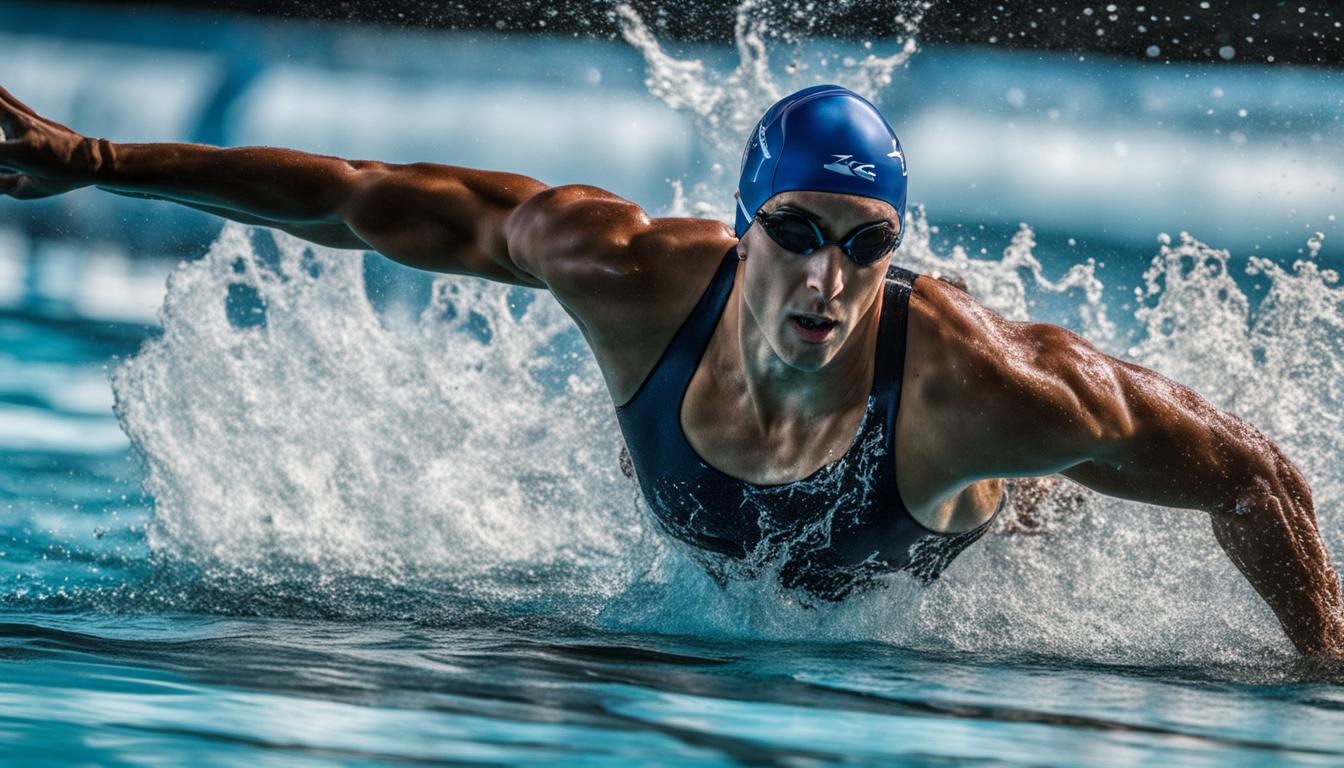Exploring Different Crawling Styles in Swimming
In this article, I will delve into the different crawling styles in swimming, including the crawl stroke, freestyle, backstroke, breaststroke, butterfly, and medley. We will explore the techniques, benefits, and historical background of each style, providing a comprehensive understanding of the various crawling styles in swimming.
Key Takeaways:
- The crawl stroke, also known as the front crawl or American crawl, is a versatile and efficient swimming style.
- Freestyle swimming offers flexibility and allows swimmers to choose any stroke they prefer.
- The breaststroke is a graceful and rhythmic swimming style that enhances muscle strength and cardiovascular endurance.
- The butterfly stroke is a powerful and challenging style that requires coordination and practice.
- The backstroke involves swimming on your back, similar to the front crawl, with unique arm movements.
The Crawl Stroke: A Versatile and Efficient Style
The crawl stroke, also known as the front crawl or American crawl, is the most widely recognized and versatile swimming style. It involves alternating arm movements and a flutter kick, propelling swimmers through the water with grace and speed.
The crawl stroke is suitable for individuals of all ages and fitness levels, offering numerous benefits. One of the key advantages of the crawl stroke is its ability to improve cardiovascular fitness. The continuous movement of the arms and the flutter kick engage multiple muscle groups, increasing heart rate and promoting efficient oxygen delivery throughout the body.
This swimming style also helps develop muscular endurance. The constant propulsion generated by the alternating arm movements and the rhythmic kick requires sustained muscle engagement, leading to increased strength and endurance in the upper body, core, and legs.
Furthermore, the crawl stroke is an effective full-body workout. It engages major muscle groups, such as the arms, shoulders, back, chest, abs, and legs, promoting overall body strength and toning.
The crawl stroke is not only physically beneficial but also a versatile technique in swimming. It allows swimmers to adapt their stroke to match their individual preferences and strengths. Some swimmers may prefer a slightly wider arm pull, while others may use a narrower movement. As long as the basic principles of alternating arm movements and flutter kick are maintained, the crawl stroke can be customized to suit each swimmer’s style and efficiency.
Proper Technique and Body Position
To execute the crawl stroke properly, swimmers should maintain a horizontal body position with a straight back and aligned head and spine. The head should be facing downward, with the eyes looking forward and the neck relaxed.
As for the arm movements, the swimmers should reach forward with one arm while the other arm is recovering above the water. The pulling arm should then bend at the elbow, sweeping back and pushing against the water to generate propulsion. The recovering arm simultaneously extends forward again to repeat the cycle.
The flutter kick complements the arm movements, providing additional propulsion. Swimmers should keep their legs straight, with a slight bend in the knees, and initiate a continuous quick up-and-down movement from the hips, generating a rhythmic flutter kick.
“The crawl stroke is a dynamic and adaptable swimming style. Its alternating arm movements and flutter kick showcase its versatility and efficiency.” – Coach Davis
The crawl stroke’s efficiency lies in its continuous and streamlined movements, minimizing energy wastage and maximizing speed. Swimmers can enhance their technique through consistent practice and receiving guidance from experienced coaches or instructors.
Historical Background
The crawl stroke, or front crawl, has a rich history in competitive swimming. It gained popularity in the late 19th century, often credited to Australian swimmer Henry Wickham. However, variations of the crawl stroke were introduced by indigenous peoples around the world long before Wickham’s era.
The American crawl, as it is known in the United States, revolutionized competitive swimming due to its efficiency and speed. Its continuous arm movements and alternating flutter kick allowed swimmers to outperform other strokes in terms of speed and endurance.
Today, the crawl stroke remains a fundamental swimming style, dominant in both recreational and competitive swimming. It continues to evolve with advancements in swimming techniques, training methods, and equipment, ensuring swimmers can unlock their full potential in the water.
Freestyle: The Fast and Adaptable Swimming Style
Freestyle swimming, often referred to as the front crawl, is a versatile and efficient swimming style. It allows swimmers to choose any stroke they prefer, with the crawl stroke being the most commonly used technique.
Freestyle swimming offers numerous benefits to swimmers of all levels, including:
- Improved cardiovascular endurance
- Increased muscle strength
- Enhanced flexibility
- Better coordination
By mastering the proper body position, arm movements, and leg movements, swimmers can maximize their performance in the freestyle style. The history of freestyle swimming is fascinating and has evolved over time, with the crawl stroke becoming the preferred technique for competitive swimmers.
In freestyle swimming, maintaining a streamlined body position is crucial. The body should be aligned horizontally, with the head facing down and the hips near the water’s surface. This reduces drag and allows for efficient movement through the water.
The arm movements in freestyle swimming involve an alternating motion. As one arm extends forward, the other arm pulls back through the water, propelling the swimmer forward. This continuous cycle of arm movements creates a powerful and rhythmic stroke.
The leg movements in freestyle swimming feature a flutter kick, where the legs kick up and down in a quick and continuous motion. This kick helps to maintain balance, stability, and forward propulsion.
Throughout history, freestyle swimming has been a cornerstone of competitive swimming events, including the Olympics. Swimmers who excel in the freestyle style often dominate sprint events, as it offers speed, adaptability, and efficiency in the water.

Breaststroke: A Graceful and Rhythmic Style
The breaststroke is a graceful and rhythmic swimming style that involves simultaneous arm movements and a frog-like kick. It offers a unique and elegant swimming experience while providing numerous benefits for swimmers of all ages and skill levels. By incorporating proper technique and body position, swimmers can enhance their muscle strength, flexibility, and cardiovascular endurance.
One of the distinguishing features of breaststroke is the frog kick. This kick involves bending the knees and bringing the legs up towards the body, resembling the movement of a frog’s hind legs. The frog kick propels swimmers forward, allowing for controlled and efficient movement through the water.
Proper body position is crucial to mastering the breaststroke. Swimmers should strive for a horizontal body alignment, with the head facing forward and the body parallel to the water’s surface. This position minimizes drag and maximizes speed, enabling swimmers to glide smoothly through the water.
The arm movements in breaststroke are symmetrical and coordinated. Swimmers start with their arms extended in front of them, then sweep them out to the sides and back towards the body, creating a circular motion. This motion generates propulsion and helps maintain the rhythm of the breaststroke.
Historically, breaststroke is one of the oldest swimming styles, with evidence dating back to ancient civilizations. It has evolved over time, becoming one of the four key swimming styles recognized in modern competitive swimming. Breaststroke is often included as one of the first swimming styles taught to beginners, as it provides a solid foundation for mastering other techniques.
| Benefits of Breaststroke |
|---|
| Improved muscle strength |
| Enhanced flexibility |
| Cardiovascular endurance |
Butterfly: A Powerful and Challenging Stroke
The butterfly stroke is a powerful and physically demanding swimming style that involves simultaneous overhead swinging of the arms and a dolphin kick. It requires coordination, strength, and practice, offering a visually impressive swimming experience.
The butterfly stroke originated from the breaststroke, with swimmers recovering their arms above the water. This technique creates a dolphin-like motion, hence the name “dolphin kick.” The dolphin kick involves both legs moving together in a wave-like motion, similar to the movement of a dolphin’s tail.
To perform the butterfly stroke correctly, swimmers must maintain a horizontal body position, keeping their head slightly above the water. The arms should be synchronized, extending forward above the water, and then recovering quickly back into the water.
The butterfly stroke is often compared to “flying” through the water due to its fluid and graceful movements. It is known as one of the most visually captivating swimming styles.
However, mastering the butterfly stroke can be challenging. The intense and coordinated movements require considerable core and upper body strength. Additionally, proper timing and rhythm are crucial to maintaining speed and efficiency in this stroke.
Swimmers who excel at the butterfly stroke often have strong shoulders, chest, and back muscles. The stroke provides an excellent workout for these muscle groups and can improve overall upper body strength and endurance.
Benefits of the Butterfly Stroke
The butterfly stroke offers numerous benefits, both physically and mentally. Here are some of the key advantages:
- Full-body workout: The butterfly stroke engages the core, upper body, and leg muscles, leading to increased strength and endurance.
- Cardiovascular fitness: The powerful movements and continuous effort required in butterfly swimming contribute to improved heart and lung health.
- Improved flexibility: The dolphin kick and the arm movements in the butterfly stroke help enhance flexibility in the hip joints and shoulders.
- Endorphin release: Like any intense physical activity, swimming the butterfly stroke can release endorphins, leading to reduced stress and increased feelings of well-being.
Mastering the butterfly stroke requires patience, dedication, and practice. It is advisable to learn this stroke under the guidance of a qualified swim coach to ensure proper technique and minimize the risk of injury.
Butterfly Stroke Table
| Key Elements | Description |
|---|---|
| Arm Movements | The arms move in a simultaneous and symmetrical motion, recovering above the water and propelling the body forward. |
| Dolphin Kick | The dolphin kick involves both legs moving together in a wave-like motion, providing additional propulsion. |
| Body Position | Swimmers must keep their bodies horizontal, slightly above the water, with the head positioned in line with the spine. |
| Strength Requirements | The butterfly stroke requires significant strength in the upper body, core, and legs to perform the powerful and coordinated movements. |

Backstroke: Swimming on Your Back
The backstroke is a unique swimming style that involves swimming on your back. It is a long-axis stroke, similar to the front crawl or freestyle, but performed with the face and chest facing upwards. This technique offers swimmers a different perspective and allows them to breathe easily without turning their heads. The backstroke is an essential skill for any swimmer as it enhances their overall swimming ability and provides relief to the muscles used in other strokes.
In the backstroke, the arm movements mimic those of the front crawl, with an alternating motion. As one arm extends above the head and enters the water, the other arm recovers above the water. The key to performing a powerful and effective backstroke lies in maintaining head and hip alignment. This ensures that the body remains streamlined and reduces drag, resulting in increased speed and efficiency in the water.
One of the challenges of backstroke swimming lies in maintaining a steady rhythm and proper body rotation. Swimmers need to coordinate their arm movements with the flutter kick of their legs, ensuring that both work together harmoniously. Additionally, swimmers must be aware of their position within the lane and navigate without colliding with the lane ropes or other swimmers.
The backstroke offers several benefits to swimmers of all levels. By engaging the muscles along the back and core, it helps improve posture and strengthens the upper body. It also enhances shoulder flexibility and promotes a balanced muscular development. Mastering the backstroke improves an individual’s overall swimming technique, making them a more versatile and confident swimmer.
Key Points about Backstroke:
- Swim on your back, face and chest facing upwards.
- Perform long-axis stroke with alternating arm movements.
- Maintain head and hip alignment for proper position, speed, and efficiency.
- Coordinate arm movements with flutter kick to achieve balance and rhythm.
- Engage back and core muscles for improved posture and upper body strength.
To visualize the backstroke technique and its key movements, refer to the image below:
Historical Background of Backstroke
The backstroke has been a part of swimming competitions for many years. It was first introduced as a competitive stroke in the late 19th century and made its Olympic debut in 1900. Since then, the backstroke has evolved with swimmers continually refining their techniques to maximize their speed and efficiency in the water.
Swimming on your back allows for an excellent stretch across the chest and is a great way to relax while still being able to swim. It’s also an important skill to have for safety reasons, as it enables swimmers to stay afloat and observe their surroundings.
As the backstroke became more popular, swimmers dedicated themselves to perfecting this technique. They aimed to achieve proper body alignment, minimize resistance, and ultimately set new records in competitive events. Today, the backstroke remains an integral part of swimming competitions, showcasing the skill and athleticism of swimmers from around the world.
The Medley: Combining All Four Strokes
The medley is an exciting swimming event that combines all four strokes in the same race. It showcases the versatility and skill of swimmers as they navigate through various techniques and challenges. There are two types of medley events: the individual medley (IM) and the medley relay.
Individual Medley (IM)
In the individual medley, swimmers use each of the four strokes for one-fourth of the race. The order of the strokes is as follows:
- Butterfly
- Backstroke
- Breaststroke
- Freestyle
This race requires swimmers to possess a wide range of skills and adaptability as they transition seamlessly between different strokes. It demands both endurance and technical expertise to excel in all four styles.
Medley Relay
The medley relay, on the other hand, involves teams of four swimmers, with each swimmer completing one of the four strokes. The order of the strokes in the relay is as follows:
- Backstroke
- Breaststroke
- Butterfly
- Freestyle
The medley relay emphasizes teamwork, coordination, and strategy as swimmers hand over to the next teammate seamlessly. It requires efficient transitions and precise timing to ensure maximum speed and efficiency throughout the race.
Medley events in swimming not only test the individual’s abilities in different strokes but also celebrate the collective strength and synchronization of a team. These events often provide thrilling moments and close finishes, captivating both swimmers and spectators alike.
| Event | Stroke Order |
|---|---|
| Individual Medley (IM) | Butterfly – Backstroke – Breaststroke – Freestyle |
| Medley Relay | Backstroke – Breaststroke – Butterfly – Freestyle |
Historical Background and Olympic Significance
Swimming has a captivating history that dates back to ancient times. From early civilizations such as the Egyptians and Assyrians to the ancient Greeks and Romans, swimming has always played a vital role in human survival, transportation, and recreation. The evolution of swimming styles over centuries has paved the way for the diverse set of techniques we see in the sport today.
In the Olympic Games, swimming has held a prominent place since their inception in ancient Greece. Modern Olympic swimming events began in 1896, featuring a limited number of individual and team races. Over the years, the Olympic swimming program has expanded to include various distances, strokes, and medley events, allowing swimmers to demonstrate their versatility and skill in the water.
Throughout Olympic history, swimmers have broken numerous records, showcasing their exceptional talent and dedication. Legends like Michael Phelps, Mark Spitz, and Katie Ledecky have set astonishing records and achieved unparalleled success in multiple swimming styles. These records inspire and motivate both aspiring and seasoned swimmers to push their limits and strive for greatness.
FAQ
What is the crawl stroke, and why is it versatile?
The crawl stroke, also known as the front crawl or American crawl, is a versatile swimming style that involves alternating arm movements and a flutter kick. It is versatile because it can be easily adapted to different speeds and distances, making it suitable for swimmers of all ages and fitness levels.
What are the benefits of freestyle swimming?
Freestyle swimming, often referred to as the front crawl, offers numerous benefits. It improves cardiovascular endurance, increases muscle strength, enhances flexibility, and promotes better coordination. Freestyle swimming allows swimmers to choose their preferred stroke, with the crawl stroke being the most commonly used technique.
How does the breaststroke differ from other swimming styles?
The breaststroke is a graceful and rhythmic swimming style that involves simultaneous arm movements and a frog-like kick. Unlike other styles, it allows swimmers to keep their head above the water throughout the stroke. The breaststroke is suitable for swimmers of all ages and skill levels and is often one of the first styles taught to beginners.
What makes the butterfly stroke challenging?
The butterfly stroke is a powerful and physically demanding style that requires coordination, strength, and practice. It involves simultaneous overhead swinging of the arms and a dolphin kick. The butterfly stroke originated from the breaststroke, with swimmers recovering their arms above the water. Its unique technique and demanding nature make it a visually impressive but challenging swimming style.
How is the backstroke different from other swimming styles?
The backstroke is a unique swimming style that involves swimming on your back. It is a long-axis stroke, similar to the front crawl or freestyle, but performed with the face and chest facing upwards. The backstroke requires maintaining head and hip alignment to ensure proper position, speed, and efficiency.
What is the medley, and how does it work?
The medley is an exciting swimming event that combines all four strokes in the same race. There are two types of medley events: the individual medley (IM), where swimmers use each stroke for one-fourth of the race, and the medley relay, where teams of four swimmers each swim a different stroke. The medley showcases versatility and skill in swimming, as swimmers must excel in multiple styles.
What is the historical background of swimming styles?
Swimming has a rich historical background and holds a prominent place in the Olympic program. Over the years, different swimming styles have evolved, each with its own techniques and characteristics. Swimming styles have been included in the Olympic program since the early 20th century, and notable records and achievements have been made in each style.









